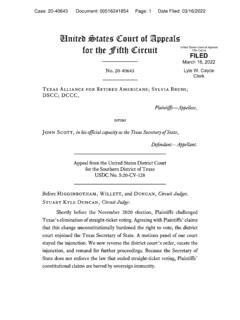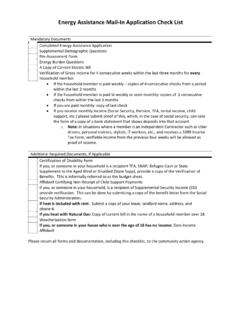Transcription of Safety First A Work Health and Safety Guide for Fitness …
1 Safety FirstA Work Health and Safety Guide for Fitness BusinessesLast revised July 2012 ContentsWork Health & Safety Responsibilities 2 Key Components of an WH&S Program 3 Success Factors for WH&S Programs 4WH&S Risk Assesment 5 Safety Inspection Checklist 26WH&S Program Checklist 29 Next Steps 31 State Work Safe Authority Contact Details 32 Dear Industry Member, Fitness Australia has a strong history of raising the standard of excellence within the Fitness industry. One example of this is to assist our Fitness businesses with developing an effective Work Health and Safety (WH&S) program. Ensuring your business has an adequate WH&S program is critical to protecting staff and clients from injury and illness and in turn, protecting the long term viability of your business.
2 This Work Health & Safety Guide has been designed in conjunction with the risk management firm, RiskLogic, in consultation with member businesses to help you learn more about this important topic. The Guide provides an easy to understand introduction to WH&S that can be used by both existing Fitness businesses and those thinking about starting a new business or changing location. It contains practical considerations with simple checklists that can help you evaluate your existing program or assist in starting a new program. Please use this Guide as another means to enhance the effectiveness and success of your Stace Chief Executive OfficerIntroduction2 | WH&S Guide for Fitness BusinessesWH&S Guide for Fitness Businesses | 3 All employers have a legal duty of care to ensure the Health and Safety of their staff.
3 This duty of care also requires the employer to ensure that people (other than employees) are not exposed to Health and Safety risks arising from the operation of the business. Work Health & Safety (WH&S) legislation within all states specifies obligations for all businesses, regardless of the number of people employed or the nature of the business. Under WH&S law, if you can affect the Health and Safety of people in the workplace, you have a legal responsibility to implement appropriate precautions. Specifically, these responsibilities include: Maintaining the place of work and working environment under your control in a safe condition. Ensuring the safe use, handling, storage and transport of equipment & substances.
4 Providing and maintaining systems of work (eg. policies and procedures) to ensure workplace Safety . Providing the information, instruction, training and supervision necessary to ensure the Health and Safety of employees. Providing adequate facilities for the welfare of employees. Ensuring that risk management procedures are implemented to identify, assess, control and monitor workplace hazards. Ensuring that appropriate employee consultation arrangements are in place and implemented. Ensuring that injuries are reported within prescribed timeframes and that a system exists to facilitate the return to work for injured WH&S legislation focuses on staff Safety , it also requires employers to ensure the Safety of any visitors to the workplace.
5 Furthermore, many of the measures required to protect employees will also apply to clients. Consequently, by implementing an effective WH&S program you can minimise the risk of injury to both staff and clients and reduce the likelihood of related fines and public liability claims. Significant sanctions exist for a breach of regulatory terms. For example, the maximum penalty for offences under the WH&S Act in NSW is $1,650,000 for corporations and $165,000 or 5 years imprisonment for individuals. Please note that state authorities (eg. WorkCover or WorkSafe) have the right to enter your premises to conduct an inspection if they believe that there have been potential breaches of the Act or effective WH&S program should address the general requirements specified by WH&S legislation as well as the specific risks associated with your example, all Fitness businesses should have procedures in place to address the following general WH&S requirements.
6 WH&S policy An WH&S policy outlines the objectives and scope of your WH&S program and demonstrates management s commitment to providing a safe Responsibilities Specific Health and Safety responsibilities and accountabilities should be provided for key positions within your business including contractors where and competencyA procedure is required that identifies the formal qualifications required for staff working for you as well as any additional Health and Safety training needs. The procedure should also cover the induction provided to new staff to ensure that they are aware of all relevant Safety procedures. Appropriate records should be kept of any required qualifications or training Consultation and Communication All businesses require a documented process, agreed to by employees, to enable employee involvement and consultation on Health and Safety identification, risk assessment and control A procedure must be developed to identify potential Health and Safety hazards, (including public Safety hazards), assess the potential risks and develop control measures.
7 This includes procedures for workplace inspections and hazard reporting (A risk assessment and sample inspection checklist to support these procedures is provided in Section 6 of this Guide ).ContractorsIf contractors are used in your business, the Health and Safety responsibilities of the contractors should be clearly defined and communicated to the SafetyA procedure is required that outlines how you will ensure that equipment is safe to use. This includes procedures for inspecting, maintaining, and repairing equipment as well as ensuring that clients are aware of the correct use of equipment. Safety considerations when purchasing new equipment should also be preparedness and responseAll potential emergency situations should be identified and emergency procedures developed to address these situations including training, First aid and equipment ManagementA procedure should exist that outlines the notification and claims management requirements for workplace injuries.
8 This may involve different protocols for injuries sustained by staff and risk prevention measuresIn addition to the above requirements, all Fitness businesses should implement measures to minimise specific WH&S risks associated with their operations (eg. slips and trips, hygiene, security, etc.) Work Health & Safety ResponsibilitiesKey Components of an WH&S Program4 | WH&S Guide for Fitness BusinessesWH&S Guide for Fitness Businesses | 5 While the above components provide the basic framework for an WH&S program that is compliant with legal requirements, it is important to recognise that implementing these components alone does not guarantee an effective WH&S program. Related research has identified a number of success factors that are critical to the effective implementation of an WH&S program.
9 These include:Visible commitment from senior managementSuccessful WH&S programs require a top down approach that demonstrates the business owner s commitment to the program. This is seen through the owner s visible support of the program, on-going monitoring of program activities, regular follow-up of Safety issues, etc. WH&S responsibilities should be reflective of line management structure in order to develop and maintain clear reporting standardised approachSuccessful programs ensure that there are clear and documented procedures that are applied in a consistent manner across the integrated into the businessRather than being seen as an add-on responsibility, successful WH&S programs integrate WH&S into the normal operations of the business.
10 Obtain clear verbal and written agreement from all staff that they understand their WH&S responsibilities (including WH&S policies and procedures) this will assist towards creating a Safety culture among all levels of objectivesSetting clear program objectives and performance targets enables effective planning strategies and monitoring efforts. Injury reduction focusPrograms that focus on the reduction of injuries as their goal instead of only legal compliance produce more successful rather than reactive approachesRather than just responding to reported hazards or incidents, effective programs take a proactive approach by identifying potential risks and ensuring that appropriate control measures are in place to minimise the likelihood of an incident program monitoringSince WH&S programs are dynamic in nature, ongoing monitoring is required to identify opportunities for improvement and to address any changes in the business activities, legislative changes, resourcesWH&S programs must be adequately resourced to ensure success.





